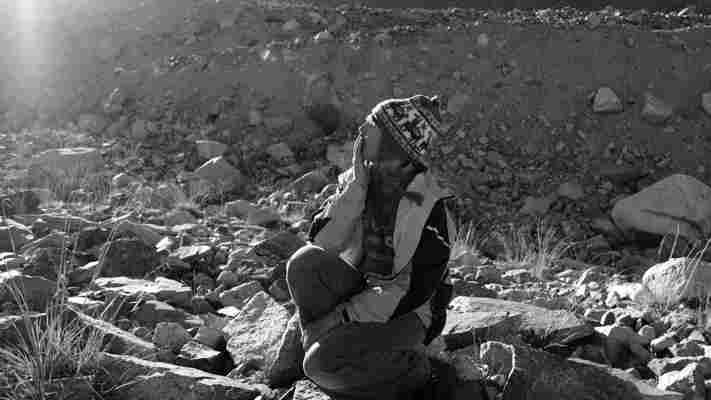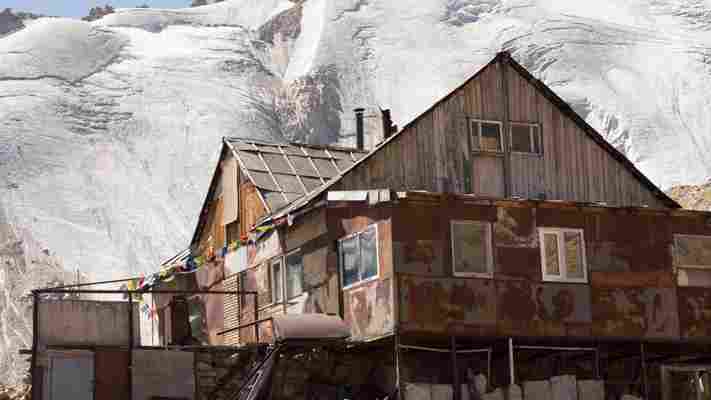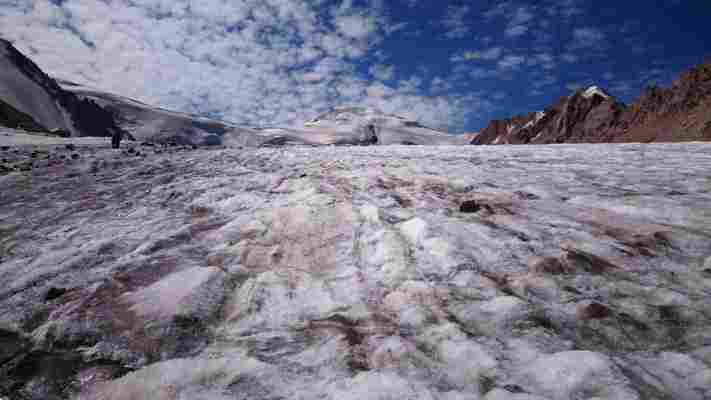Life at 3,500m is one of solitude, where capricious winds whip four seasons past in a day, affording the hours an elasticity that is anchored only by the rising and setting of the sun. In the northern Tian Shan mountain system that skims the edge of Almaty, Kazakhstan’s largest metropolis, existence at this altitude would seem impossible if it wasn’t for Aušra Revutaite, a Lithuanian scientist who has called this remote outpost home for more than 30 years.

On a frigid October morning, I made my way up into the Tian Shan mountains, heading for the Tuyuksu glacier, one of the main freshwater sources for Almaty’s 1.8 million residents and more in the plains beyond. I grew up in an isolated, centuries-old Welsh cottage close to a river’s headwaters, where the sound of a stream provided the soundtrack to my childhood. With my family, I walked to the water’s source more times than I can remember, inspiring a lifelong fascination with origins and beginnings that has informed the way I travel. In Almaty, I wanted to go on a similar journey, unaware that when I reached my destination, I would meet Revutaite.
During the 45-minute drive out of the city, I watched as great concrete hulks of Soviet-era architecture surrendered to unforgiving alpine inclines, until the road turned to rock. My guide, Alexey Raspopov, parked the 4x4 and we prepared to climb on foot.

Lithuanian scientist Aušra Revutaite has lived in a remote outpost in Kazakhstan’s Tian Shan mountain range for more than 30 years (Credit: Audrius Stonys)
Our two-hour ascent into the mountains passed swiftly, punctuated by pauses for breath and water. My eyes occasionally wandered off the trail to study the austere and ancient landscape around me. Below us, morning’s advance was tainted by a sluggish brown shadow of smog that obliterated the sprawling metropolis from view.
You may also be interested in: • Can science and tourism save the Great Barrier Reef? • The sinking islands of the Southern US • The birthplace of the modern apple
At our apex of 3,500m, the Tuyuksu glacier stood as it had for centuries, an ancient mass of compressed ice and snow. “It is much smaller today, it used to come out to here,” Raspopov told me, miming an expanse far beyond us, explaining that the glacier had been withdrawing for decades. According to Maria Shahgedanova, a professor in climate science at The University of Reading in England, Tuyuksu has retreated by more than 1km in the past 60 years, watched over by Revutaite, a meteorological observer who has been recording its retreat due to the changing climate.
Around us was an assemblage of dilapidated and neglected shacks and outhouses. As I wondered how anyone could endure such seemingly ascetic conditions, Revutaite appeared from the largest, least ramshackle building, about 20m away. Bundled in warm clothing that obscured her identity, she seemed to derive no comfort in finding two visitors approaching her. Instead she studied us with impatience, until, on recognising Raspopov, she smiled faintly, her face a mirror of the mountains: profound; still; intractable.
As we got nearer, I could see a desk through the windows behind her, long and narrow and covered in a blue tablecloth peppered with yellow suns. Piles of paper, open notebooks and what looked like an antique seismograph suggested we had interrupted her at work. She was a woman of almost no words; a lone figure who somehow seemed at home in the inhospitable environment so removed from the swiftly modernising city I had left behind just hours earlier. A dog and a cat played nearby, offering their wordless companionship.

At 3,500m, the Tuyuksu glacier is one of the longest studied glaciers in the world (Credit: Audrius Stonys)
Originally from Lithuania, Revutaite arrived at Tuyuksu in 1982, while Kazakhstan was still under Soviet rule. Part of the World Glacier Monitoring Service Network (WGMSN), the Tuyuksu measurement station was established in 1957 and glaciological and hydrometeorological observations have been measured ever since, making it one of the longest studied glaciers in the world.
“Monitoring glaciers can tell us a lot about climate change,” said Isabelle Gärtner-Roer, senior scientist in glaciology and geomorphodynamics at the University of Zurich in Switzerland, who works with the WGMSN. “Changes in the glacial mass balance are the direct and undelayed response to atmospheric climate change,” she added, explaining that this makes them essential to climate monitoring. “Glacier melt has been recognised as one of the largest nonsteric contributors to sea-level rise.”
Since 1972, findings have been recorded at Tuyuksu year round, providing climate scientists with the data they need to investigate nature’s response to global warming. These findings show the glacier’s alarming retreat could have a devastating effect in the decades ahead, not only for Almaty but for all of Central Asia.
Changes in the glacial mass balance are the direct and undelayed response to atmospheric climate change
Without Revutaite, who in some years single-handedly kept the meteorological station running, the accumulation of such comprehensive statistics might not have been possible.
“Aušra is our hero! But a very shy one,” said Shahgedanova, speaking on behalf of colleagues from the Kazakhstan Institute of Geography. Shahgedanova explained Revutaite’s role: reading instruments; collecting data; measuring how much ice is lost and gained by the glacier over time; studying its glacial mass balance. Hers is a world of weather charts and instruments and routine, where she is the only constant – Tuyuksu ebbs and advances with the seasons; the mountains are shaped by meltwater and landslides. Even as climate change hastens these environmental alterations and makes them more extreme, Revutaite remains. She silently watches as the world slowly warms up.
“We owe the fact that the Tuyuksu station measurements and mass balance programmes have been running without interruption, particularly during the very difficult 1990s, to her,” said Shahgedanova, referring to the turbulent decade that saw the dissolution of the Soviet Union, when the newly independent nation inherited a weak state and precarious economic situation.
Since 1982, Revutaite has lived alone at the Tuyuksu measurement station (Credit: Audrius Stonys)
Not that Revutaite expects any acclaim for her dedication to Tuyuksu. When Lithuanian filmmaker Audrius Stonys first approached her in 2012 to be the subject of a documentary he was filming in the Tian Shan mountains, she turned him down.
“I don’t want to be in the film,” she had told him.
He entreated her, telling her that he hoped to document her work, to which she responded: “I don’t want people to see my work, I want to disappear.”
Revutaite’s mind was changed when she saw some of the footage Stonys had filmed of her beloved mountains. Filmed over the course of three summers, The Woman and the Glacier is a meditative study of the mammoth mass of ice, capturing its grandeur and frailty. Devoid of dialogue or distraction – just like Revutaite’s life at 3,500m – the viewer observes as she makes her recordings against the background of the Tian Shan; the mountains and their machinations as much of a presence as the woman who has dedicated her life to them.
The Tuyuksu glacier provides water for domestic, industrial and agricultural use to the city of Almaty and the surrounding region (Credit: Nikita Melnichenko/Alamy)
What the film fails to capture, however, is the uncertainty that clouds Tuyuksu’s future.
According to Shahgedanova’s research, fuelled by Revutaite’s comprehensive data collection, the region’s glaciers are currently losing their area at a rate reaching 1% per year, and there is strong evidence linking this decline to climate change. If the negative trend continues, it could have a calamitous impact on the millions of people who depend on Tuyuksu and Tian Shan’s other glaciers for their water.
Across Central Asia, rivers, most of which start in the mountains, supply up to 90% of water for domestic, industrial and agricultural use, and Almaty is no exception. Rivulets run from Tuyuksu on a desperate race downwards to merge into the Little Almaty River, which wends its way through the city and out onto the plains beyond.
“There is no immediate concern about water availability in the natural catchments,” Shahgedanova said. “Having said that, modelling shows if Tuyuksu continues to shrink at this rate it may not be sustainable, and by the 2040s we expect a reduction in summer discharge. If our predictions are right, the implications will be negative.”
Findings recorded at Tuyuksu provide climate scientists with the data they need to investigate nature’s response to global warming (Credit: Audrius Stonys)
For now, Revutaite continues to man her lonely post on the glacier, making bi-weekly trips down to the city for supplies and interacting only with those, like Shahgedanova or Stonys, who respect her environment as much as she does. Although she has no modern conveniences or creature comforts, no internet connection or phone signal, Revutaite has found her home at Tuyuksu.
I often think of her, alone in her isolated abode made of tin and wood panels surrounded by a hostile sky. I cannot predict how the glacier will change, but I know that she will be there. She might not have the power to prevent the climate from changing, but she has spent much of her life observing, recording and bringing global warming’s advance to a greater audience, and for that she should be celebrated, whether she agrees or not.
Join more than three million BBC Travel fans by liking us on Facebook , or follow us on Twitter and Instagram .
If you liked this story, sign up for the weekly bbc.com features newsletter called "The Essential List". A handpicked selection of stories from BBC Future, Culture, Worklife and Travel, delivered to your inbox every Friday.
Leave a Comment